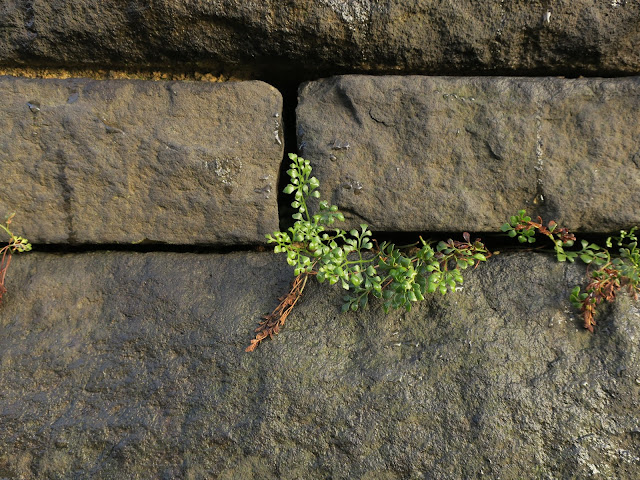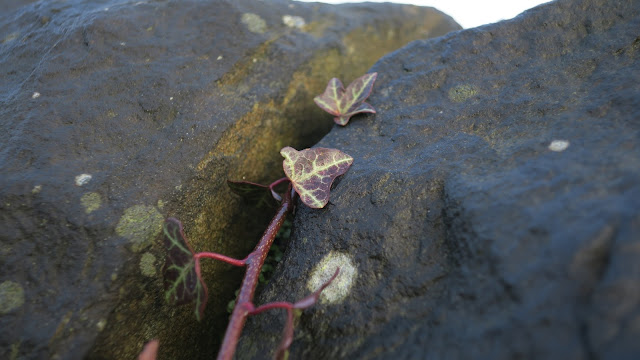I've decided, for the moment, to keep comparing. Contrasts are interesting. They matter.
The dark walls of Halifax and the surrounding fields bothered me when we arrived. Gloomy. I wasn't sure whether this blackness is intrinsic to the stones the walls are made from or whether it's soot. London used to be black. Westminster Abbey used to be black. Look at it now!
And I can't answer this yet. (Don't worry. I'll find out. Plenty of time.)
I'm getting used to them. What's more, they are a good place to find street plants. So it's another new experience - to look sideways and up, not just down by my feet.
The picture above . . . I think I'll have come back to this exact spot when I do my next 'stuck foot' post. I'll take photographs just of the plants in this immediate scene. So many crammed in together.
Here's a confluence of themes. I'm getting used to a green instead of white light when it rains and finding it's interesting to notice familiar plants in a new context. Groundsel; but camouflaged. The plant and the green on the wall in the rainy late-afternoon light of a January day are in harmony. A unity. An invisibility. It's a surprise. A new experience. When it rains, black walls turn green!
I don't know what this plant is. Can you tell me?
What about this one?
This fern below?
Does it strike you that the stones look like petrified wood?
Why is this ivy red? Can anyone explain?
And below - a foxglove!
Until I came here, I'd not thought of foxgloves as urban wild plants. Very country hedgerow I'd have said. That was . . . until the first post on this blog when I found them growing on top of another wall.
On moving from Dorset to West Yorkshire I started again with 'Loose and Leafy in Halifax'. Maybe I made a mistake. Perhaps I should have created a blog dedicated solely to this wall!
Tweet
If you'd like to join me in noticing and admiring plants growing wild in towns and cities . . . I'll be putting a link box for Street Plant Posts on Loose and Leafy, 1st - 7th February.







32 comments:
Interesting post and pictures of plants so often overlooked. xx
So your fern is maidenhair spleenwort, one of my very favourite wall plants (and plant names) and the one that popped into my head when I started reading your post. Imagine my joy seeing that you'd found one! Love the way the wall colours change with the weather and the camo groundsel. Just been to visit Imperfect and Tense and saw your comment about the deep, round footprints by your bulbs. I suspect rabbits.
so many wild and wonderful things growing in such a small area. well spotted! xxx
Vertical planting! A wide variety. I’m afraid I’m not good with names but they certainly brighten the walls. Extraordinary green stone after rain and the photo below does look like petrified wood.
Great to hear you will be hosting a street plant gathering, thanks!
Hello Flighty. As you know, I enjoy hunting for 'overlooked' plants - though once you get your eye 'in' you can't fail to notice them everywhere.
Hello Countryside Tales. Thanks for the ID.
Re. footprints. These look like plod-plod-plod footprints, not leaping or pottering or sitting down to have a look around kind. I'll keep an eye out for scat.
Hello Lyn. I like the 'street garden' sort of sites. Nature arranges!
Hello Liz. I'm used to lichens changing colour along with rain or sun - I imagine there's something tiny like that in there / on there. It's most noticeable towards ground level where rain from the pavement bounces up so it gets a double-drenching and probably takes longer to dry.
Hello Hollis. I really like doing the street plant posts and hope others will join me. As I'm gradually getting settled into this new blog I'll soon start up with 'Stuck Foot' posts again too. I now have an allotment and am writing about that so I'll have to take care not to spend all my time blogging instead of doing other things too.
I must admit that I tend to overlook plants growing in such an urban setting such as this, I think we, well I, tend to go about my everyday life without looking closely enough. I doubt I'd have noticed that foxglove growing on a wall, though it's amazing how plants will thrive in the most unlikely of places, isn't it?
Hello Jo. I doubt I would have become as interested as I am in these random plants about town if I didn't have the blog. I start with the wider scene and narrow in and narrow in and in the process find these delights. And once found . . I keep looking.
The wonderful thing is that the stones look as organic as the plants. It really is a very appealing combination. If this is what the future holds you will be very happy in Halifax!
Photos like yours always remind how persistent nature is to make any little space work for life.
The stone does set the plants off a treat. Spleenwort and a small Hartstongue fern.
Beautiful great photos!
Afraid I can’t help you much with the names of the plants but I do think it’s rather amazing how the foliage finds the slightest bit of earth to cling to. They’re top heavy but ridiculously easy to pluck because their roots aren’t deep. Deep roots are important as were your questions, which I was happy to answer in my own comment section. :)
Always interesting to see plants growing where not expected. Off to add your new blog address to my list.
I've always loved seeing plants growing in walls. It's as if they had to struggle to be there and they persevered. Lovely photos!
Wild gardens like this are wonderful - in an aesthetic sense and also the way they show the determination of plants to do what they do naturally : plant themselves. A beautiful wall, and generously built with spaces for plants.
Hi Lucy -- I am no good at plant ID, but I can tell you that I love stone walls. And always admire the brave little plants and flowers that bloom in inhospitable places ... and tiny cracks in stone walls seem to qualify as that... and yet the plants are lovely ... just keeping on keeping on -- kind of a lesson for all of us. Like the poster I saw once said "Bloom where you're planted" .
Splendid post - I'm always amazed at the places plants can find a foot holds. I think one of the plants is called Wall Rue.
Cheers - Stewart M - (back in) Melbourne
Hello David. It's quite astonishing how common these walls are here. Dry stone walls in Dorset tended to be reserved for field edges . . and I don't know whether it was because of the kind of stone used or the way they were cared for but among the ones I was familiar with, there were fewer plants growing in them.
Hello Carol. Yes. Nature is very busy and persistent. But there's a tension. I enjoy finding these wild plants in a city, I think they enhance it but, left to its own devices, it could reduce our cities to rubble.
Adrian - thanks for the IDs.
Hello Birgitta. I'm glad you like the photos.
Hello Penelope. After reading your reply on your blog I found Noor on Facebook. I didn't find the particular poem you mention but appreciated this video on lots of levels.
https://www.facebook.com/themuslimvibe/videos/1033776943443973/
Hello Alister. I'm glad you've added my new blog to your list because I won't be posting to the old one now - except, perhaps, if I go back for holidays. Halifax is so incredibly different from Dorset, it seemed sensible to make a new blog to reflect my new surroundings; but it's always a risk when you do this in case people don't realise you've moved, just just think you've stopped blogging.
Hello Sharon. Yes. I agree. Plants in walls feel like a symbol of resilience. They tend to be small but they are very tenuous. Almost imaginative in the footholds they find for themselves. But there are buddleia and ivy in walls too - strong enough to shift stones and, therefore, destructive. So they symbolise a different kind of strength. Maybe the might of nature!
Hello Catmint. Since I took these photos I've been back to look more carefully at this wall's structure - which is common to this area. There are actually two walls, next to each other but with a space between which has been filled with stone rubble. Along the top, joining them, are longer, flat stones with larger ones, almost rocks, placed on top. They have rounded tops so the rain runs off and are heavy enough to keep the whole structure in harmony with itself and in place. This means that if a stone shifts from one side, the wall does not fall down and the stone can be slotted back into position. A lot of work (and strength!) must have been put into their construction but they are long lasting!
Hello Sallie - yes, bloom where you are planted . . . but choose where you are planted too!
Hello Stewart. These plants remind me somewhat of shellfish and anemones which survive on rocks thrashed by seas and tides. Incredibly surprising. Incredibly resilient. (And with shellfish, that they could get up and walk around a bit then slot themselves exactly back into their own special grove still astonishes me.)
Post a Comment